Overview
Similar to Custom / Special Pricing, SalesPad’s group pricing module allows users to set up special pricing for a group of customers or a group of customer addresses.
Any applicable customer special pricing will override group pricing. Group pricing only works with standard pricing, not extended pricing, in Dynamics GP.
Setup
The group pricing module (available from the menu under Sales, displays any existing group pricing that has already been set up. Aside from group names, existing Group Pricing setup can be modified as needed (*). Below is a view of what the module should look like followed by a split view of the module:
Standard View

Split View
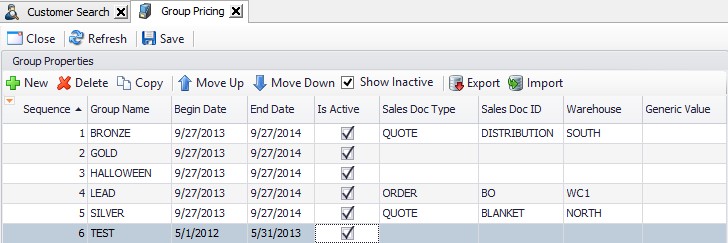

Add Groups
Under the Group Properties grid, click New. The following pop-up will appear.
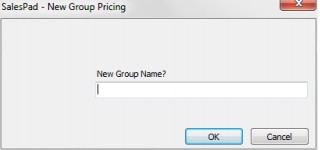
Enter a name for the group. You cannot change the name of the group once it is confirmed. Click OK to confirm the group name and return to the group pricing screen. The new group will appear as a line under Group Properties.
Modify the Begin and End dates as needed (the default is Begin – today, End – one year from today). The Is Active column indicates whether the group pricing is currently on or off. Make sure the box is checked for group pricing that should be active.
The Sequence field determines the priority in which different groups take precedence, in case more than one group pricing can be applied (lower number means higher priority.) Use the Move Up and Move Down buttons to change the sequence order.
Sales Doc Type, Sales Doc ID, Warehouse, and Generic Value are all optional values for further restriction. These options are available in newer versions of SalesPad.
Note: The Generic Value functionality requires customization. It does not work out of the box, and you will need to override the pricing stored procedure by adding a custom spcpGetItemPriceNonExt script in SQL.
The values for field Generic Value can be set up in Security > Group Pricing > Generic Value Options:
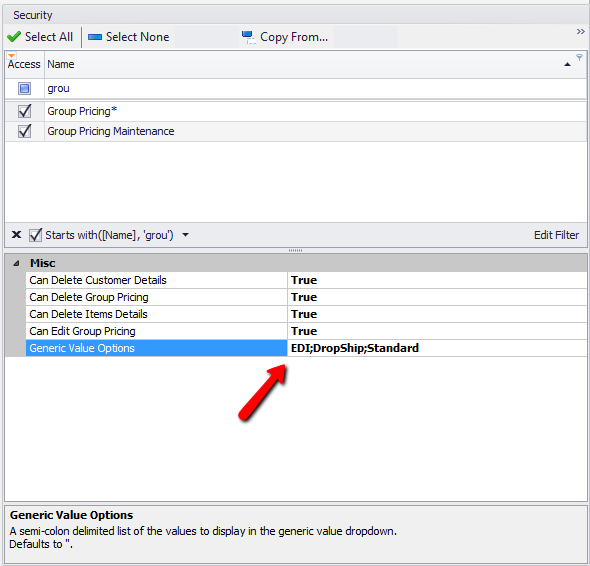
Also, the setting Pricing Generic Value Parameters allows you to define the additional parameters to pass to the custom stored procedure spcpGetItemPriceNonExt that you will create:
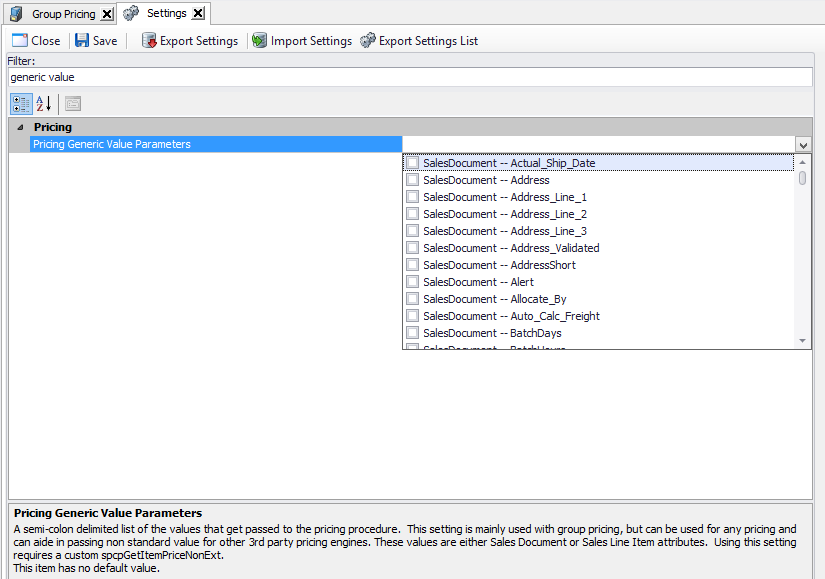
Add Items (Item Number)
After a group has been added, add items to be specially priced for the group in the Items tab under the group details grid.
Select the group to apply the item from the Group Properties column
Click New Item. A new line will appear with the selected group named under group name

Enter the Item Search Value or click the ellipsis (...) to look up and select an item from the sales inventory lookup screen. Sales inventory lookup must be enabled in the security editor. See inventory lookup.
The item description will automatically be filled in on the line. Select a unit of measure (UofM) by which the group pricing will be priced.
Note: UofM is a required field.
Select the appropriate combination of price type and price source. The possible options are:
- Fixed Amount (Type) and None (Source) – The unit price in the document will be the value in the Adjustment field.
- Percent Adjustment and List – Percent of list price in dynamics GP.
- Amount Adjustment and List – Amount adjustment of list price. (Example: if list price is $50.00 and adjustment is $5.00, the final price will be $55.00.) This field can accept negative numbers.
- Markup Percent and Standard Cost – Percent markup of standard cost in GP.
- Markup Percent and Current Cost – Percent markup of current cost in GP.
- Margin Percent and Standard Cost – Percent margin of standard cost in GP.
- Margin Percent and Current Cost – Percent margin of current cost in GP.
Enter the price/percent under Adjustment, then enter a starting quantity and ending quantity Qty Start & Qty End. Quantities entered are per line item on the sales order, not lifetime quantities.
You can set up multiple prices for different quantity ranges on the same item by adding the item on multiple lines.
Add Items (Item Class)
Group pricing allows users to specify pricing details at the item class level as well. The Items tab in newer SalesPad versions features a column called Match Field Name. This field allows users to specify whether the price detail will apply to a specific item number or all the items of a specific item class.

Item Number – By default, column Match Field Name is set to Item Number. This way the user can choose the item number (by typing it in the cell, or by using the Inventory lookup) in the column Item Search Value. (This column was formerly called Item Number.)
Item Class – If Match Field Name is set to Item Class, the field Item Search Value will have a dropdown from which the user can choose the item class from a list of possible options (item classes available in GP).
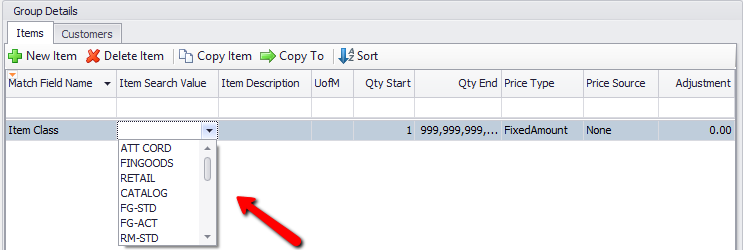
Add Customers
Add eligible customers to the group on the customers tab:
Select the group, then click New Customer. A new line will appear with the selected group under group name:

Enter the customer number or click the ellipsis (...) to search for and select the customer from the customer lookup screen. Specify the address code (optional). If no address code is specified, the price will be applied to any addresses for the customer.
Customer lookup allows the user to select one or more customer:
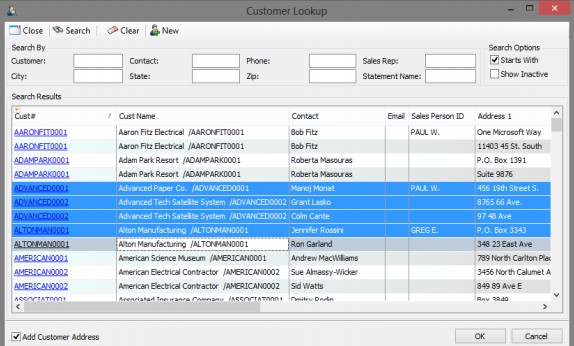
If the check box Add Customer Address is checked (bottom left side of the screen), the lookup will return all customers with the addresses selected. Otherwise, only the customer numbers will be returned.
The customer name will automatically appear under customer name.
Click Save and repeat the process for additional groups, items, and customers.
Copying Groups and Pricing
Existing groups and their associated item pricing/customers can be copied using the Copy Group button.
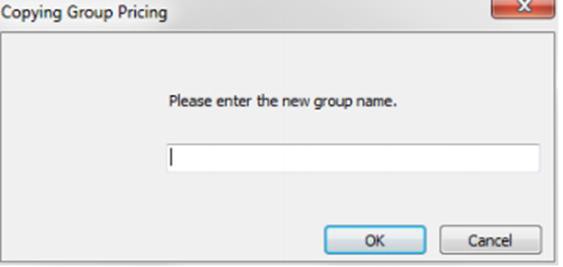
Enter a new name for the group. Once added, the new group can be modified.
Note: The input box will no longer be available starting from Custom build 4.3.x, giving users the flexibility to have multiple group pricing with the same group name.
Group Pricing Update
Group pricings can be easily kept up to date using the Group Pricing Maintenance form. Please refer to the Group Pricing Maintenance documentation for more detail.
Use
On the sales document, the group price will display and be used instead of the default price for any group priced item added for an eligible customer.
Exporting User Fields
Group pricing can be exported to .xml files for backup purpose or to copy pricing across databases. Follow the steps below in order to export:
Click the export option under the menu “Import/Export:”

This will pop up a small window from which the user can select the groups to export:
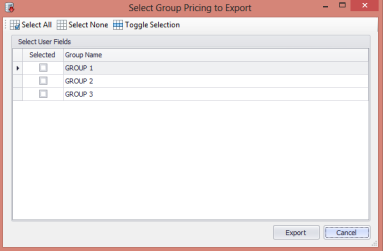
Select the groups to export by checking the box under the Selected column. The user can also select multiple rows and click Toggle Selection to select/unselect multiple names. Also, the user has the option to Select All or Select None.
Click Export. This will open up the save as dialog box from which the user can browse the location and the name of the .xml file that is going to be saved.
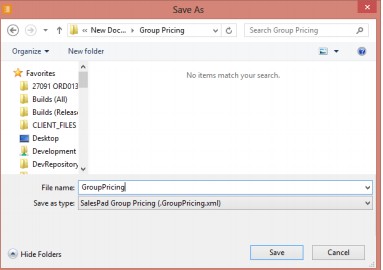
Importing User Fields
Group pricing can also be imported from .xml files. Follow the steps below to import groups.
Click the Import button
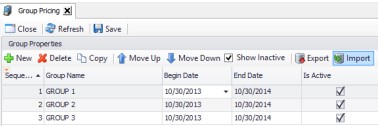
In the window that appears, browse to the location of the group pricing’s .xml file and click “Open.”
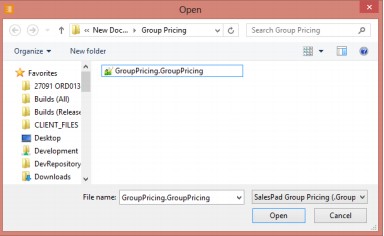
The select group pricing to import screen appears. Select the groups to import by clicking the check box under the “Selected” column.
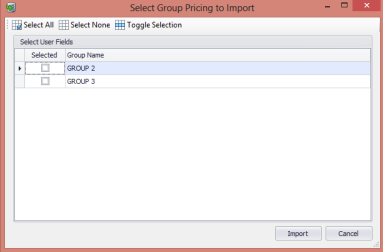
The user can select multiple rows and click Toggle Selection to select/unselect multiple fields. The user also has the option to Select All or Select None.
Once the groups to import have been selected, you can click OK. You will return to the group pricing main form. The new groups should now be part of the table.
Note: Imported groups are not saved automatically; you must click Save in order to save them.
Group Pricing Excel Import/Export
Group pricing has the option to import or export group pricing from and to Excel files. For more details see documentation Group Pricing – Excel Import/Export.
Security
Group Pricing* - Allows users to access the Group Pricing module.
Settings
Reprice When Qty Changes - Allows users to change the quantity on a line and apply group pricing.
Pricing Generic Value Parameter - A semicolon delimited list of the values that get passed to the pricing procedure.
SalesPad Support
Comments
Ken Gauld
Jason, that is often required because pricing and promotions are typically per customer (and the price level assigned), by date, by the quantity, etc. To build a price query screen would require specifying all of that prerequisite data to run the price check. It could be done as a custom project if you wish, there's an RFQ form you can submit for more info. Have you considered using the Sales line pricing trace tool, it might be of interest to you. https://support.salespad.com/article/1985-sales-line-pricing-trace
Jason Pearce
How do I see the price of an item? is the only way to see the price to add it to an order?